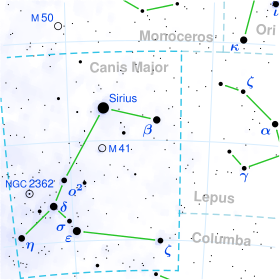Omicron2 Canis Majoris
| Observation data Epoch J2000 Equinox J2000 |
|
|---|---|
| Constellation | Canis Major |
| Right ascension | 07h 03m 01.47211s |
| Declination | –23° 49′ 59.8523″ |
| Apparent magnitude (V) | 3.043 |
| Characteristics | |
| Spectral type | B3 Ia |
| U−B color index | –0.778 |
| B−V color index | –0.107 |
| Variable type | α Cyg |
| Astrometry | |
| Radial velocity (Rv) | 48.4 km/s |
| Proper motion (μ) |
RA: –2.21 mas/yr Dec.: +3.61 mas/yr |
| Parallax (π) | 1.18 ± 0.40mas |
| Distance | approx. 2,800 ly (approx. 800 pc) |
| Absolute magnitude (MV) | –7.3 |
| Details | |
| Mass | 21.4 ± 2.2 M☉ |
| Radius | 65 R☉ |
| Luminosity | 220,000 L☉ |
| Surface gravity (log g) | 2.05 cgs |
| Temperature | 15,500 K |
| Rotational velocity (v sin i) | 58 km/s |
| Age | 7.4 ± 1.0 Myr |
| Other designations | |
| Database references | |
| SIMBAD | data |
Omicron2 Canis Majoris (ο² CMa, ο² Canis Majoris) is a star in the constellation Canis Major. Since 1943, the spectrum of this star has served as one of the stable anchor points by which other stars are classified. It has an apparent visual magnitude of 3.043, making it one of the brighter members of the constellation. The distance to this star is roughly 2,800 light years (800 parsecs), with a 34% margin of error.
This is a massive supergiant star with a stellar classification of B3 Ia, indicating that, at the age of around 7 million years, it has exhausted the supply of hydrogen at its core and is now undergoing nuclear fusion of helium to generate energy. It has about 21 times the mass of the Sun and 65 times the Sun's radius. In all likelihood, it will end its life as a Type II supernova.
Omicron2 Canis Majoris is one of the most luminous stars known, as it radiates about 220,000 times as much luminosity as the Sun from its outer envelope at a temperature of 15,500 K. At this heat, the star is glowing with the blue-white hue of a B-type star. This star is classified as an Alpha Cygni-type variable star that undergoes periodic non-radial pulsations, which cause its brightness to cycle from magnitude +2.93 to +3.08 over a 24.44 day interval. It is losing mass from its stellar wind at the rate of around 2 × 10−9 times the mass of the Sun per year, or the equivalent of the Sun's mass every 500 million years.
While this star lies in the field of view of the open cluster named Collinder 121, it is unlikely to be a member. In fact, its optical neighbor, the orange supergiant ο1 Canis Majoris has a much higher likelihood of 23.1% based upon its proper motion being a closer match to the motion of the cluster. Although they are located near each other on the celestial sphere, ο1 CMa and ο2 CMa are most likely not gravitationally bound to each other as they appear to lie many light years apart.
...
Wikipedia

